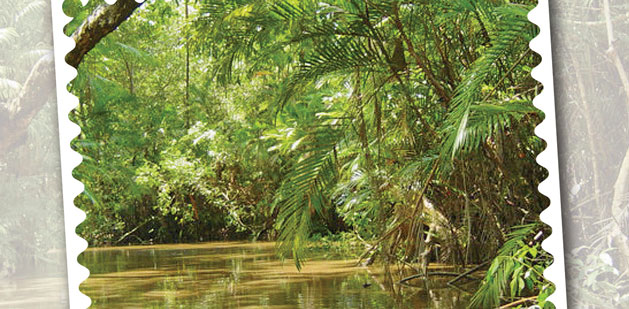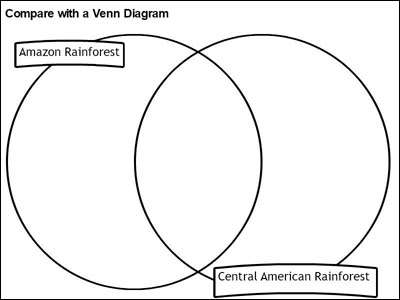
Students will think critically as they analyze differences in rainforests around the world through research and the creation of postcards.
Apps: Wixie®

Students research a specific rainforest and create a series of postcards from a fictional visit. Students share their experiences with the rest of class and compare similarities and differences between rainforests around the world.
Begin by reading the book The Kapok Tree by Lynne Cherry. This is a story of a young man in the Amazon rainforest who has been told to cut down the Kapok Tree. However, he grows tired and falls asleep. While the young man is sleeping at the base of the tree, he dreams about many animals who beg him not to cut down the tree.
After reading the story, discuss the idea of interdependence in ecosystems with your students. Because you will task them with creating postcards that showcase differences in rainforests located around the world, this is a great opportunity to also discuss diversity, symbiosis, and food webs.
Before students begin researching a specific rainforest, be sure students have a clear understanding of what a biome is and can define characteristics of the rainforest biome.
Divide the students into five equal teams. Let them know that will be working together to "explore" and learn more about one of five tropical rainforests around the world:
Have student teams complete research about their rainforest region. Using information from their research, students should be able to answer:
Let students know that after they complete research, they will create a series of postcards that reflect what they see in the rainforest in their specific region.
While most students have seen a postcard, share a few examples that show high quality images and collages on the front as well as engaging writing on the back. If you can’t find an example, send one to yourself during summer vacation or make a high-quality example.
As a team, students should review their research and decide what information should be covered, so that the entire group’s postcards are a summary of their rainforest region. You may want to have the students use a storyboard to organize and decide which content will be shared on each separate postcard.
As a set, the postcards should contain information about the following:
Team members can then choose which postcard they will design. Students can use a tool like Wixie to work individually on their own postcard or use the collaboration options to work together to design each card.
Each postcard should be a synopsis of what they saw on a given day. The front of the postcard should include original artwork or photographs and the back will include engaging text describing what they saw, heard, smelled, and touched that day.
Students should print their postcards to share with their classmates. You can also display their finished postcards on a classroom web site and even combine them all into one file.
Have the Central American rainforest expedition and the Amazon rainforest expedition share their postcard web sites.
As a whole class, compare the Central American rainforest to the Amazon rainforest. Use a Venn diagram to determine the similarities and differences between these rainforests. Next, have the Congo River Basin rainforest expedition, the Madagascar rainforest expedition, and the Southeast Asia rainforest expedition share their postcard web sites.

As a whole class, compare the three rainforests. Use the three-circle Venn diagram to determine the similarities and differences between these rainforests.
After reading the Great Kapok Tree, ask students to respond to the literature. For example, how important was the Kapok tree and to whom?
When students are completing research about their region, assess their answers to the research questions to make sure they can tell you what plants and animals are found in this region as well as what makes this region unique from other rainforest regions around the world.
To get the students thinking about the environment, ask them to brainstorm other examples where our ecosystem is in danger. You will also be able to assess some of the students’ basic knowledge about the rainforest.
You will be able to assess student comprehension after the project as you use Venn diagrams to compare the various rainforests.
Lynne Cherry. The Great Kapok Tree. ISBN: 0152018182
Mongabay Kids: Tropical Rainforests
National Geographic: 15 Fantastic facts about rainforests
Earth and Space Science: Earth's Systems
3-ESS2-2. Obtain and combine information to describe climates in different regions of the world.
CCSS.ELA-LITERACY.W.3.3
Write narratives to develop real or imagined experiences or events using effective technique, descriptive details, and clear event sequences.
CCSS.ELA-LITERACY.W.3.4
With guidance and support from adults, produce writing in which the development and organization are appropriate to task and purpose.
CCSS.ELA-LITERACY.W.3.5
With guidance and support from peers and adults, develop and strengthen writing as needed by planning, revising, and editing.
CCSS.ELA-LITERACY.W.3.7
Conduct short research projects that build knowledge about a topic.
3. Knowledge Constructor
Students critically curate a variety of resources using digital tools to construct knowledge, produce creative artifacts and make meaningful learning experiences for themselves and others. Students:
a. plan and employ effective research strategies to locate information and other resources for their intellectual or creative pursuits.
b. evaluate the accuracy, perspective, credibility and relevance of information, media, data or other resources.
c. curate information from digital resources using a variety of tools and methods to create collections of artifacts that demonstrate meaningful connections or conclusions.
6. Creative Communicator
Students communicate clearly and express themselves creatively for a variety of purposes using the platforms, tools, styles, formats and digital media appropriate to their goals. Students:
a. choose the appropriate platforms and tools for meeting the desired objectives of their creation or communication.
b. create original works or responsibly repurpose or remix digital resources into new creations.
d. publish or present content that customizes the message and medium for their intended audiences.

Follow us on Instagram for daily inspiration

Create a thought web, cluster, flowchart, or other graphic organizer for a lesson
Creating timelines with Wixie's Mind Map tool
Creative, digital book reviews
Fun and powerful ideas with animated characters

Wixie
Share your ideas, imagination, and understanding through writing, art, voice, and video.

Rubric Maker
Create custom rubrics for your classroom.

Pics4Learning
A curated, copyright-friendly image library that is safe and free for education.

Wriddle
Write, record, and illustrate a sentence.

Get creative classroom ideas delivered straight to your inbox once a month.
Topics